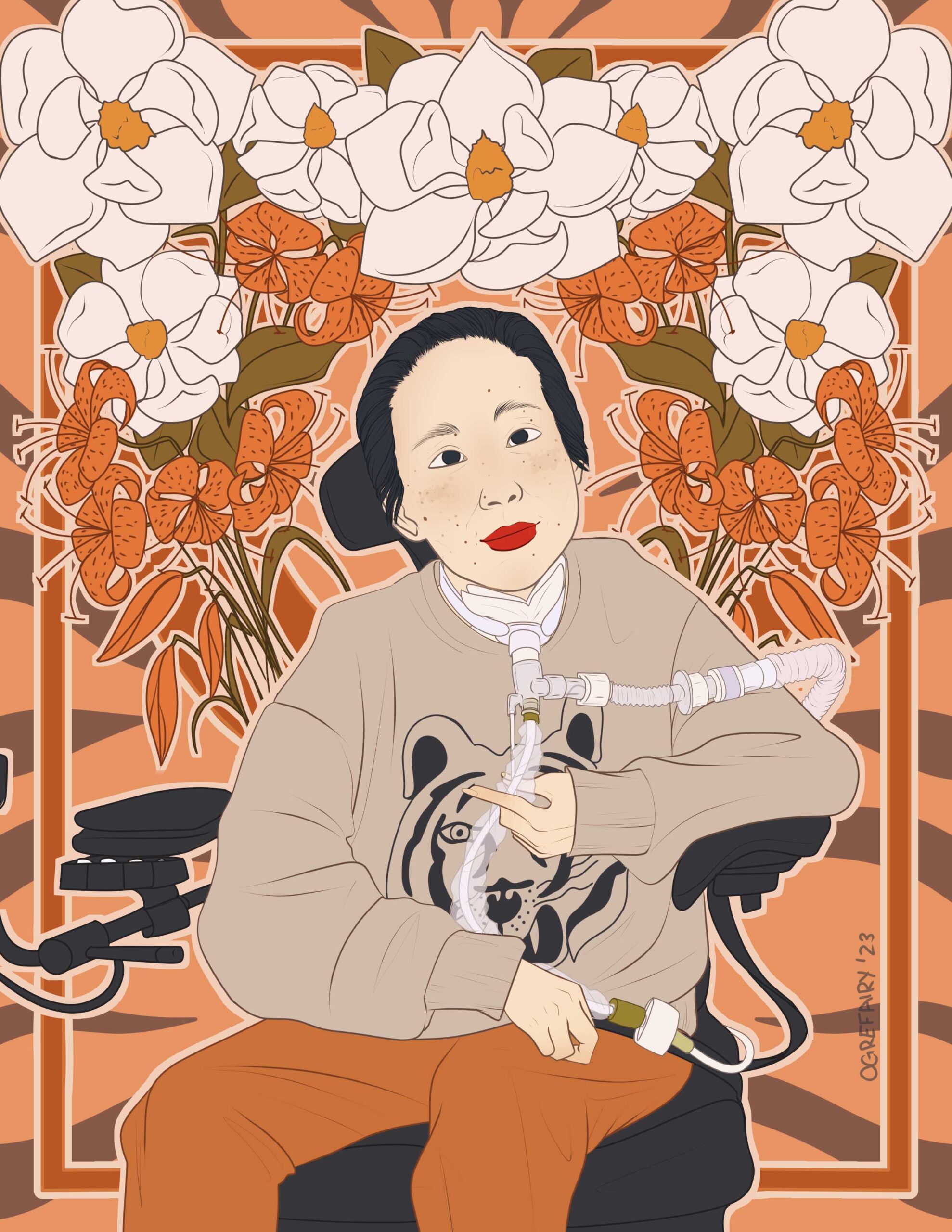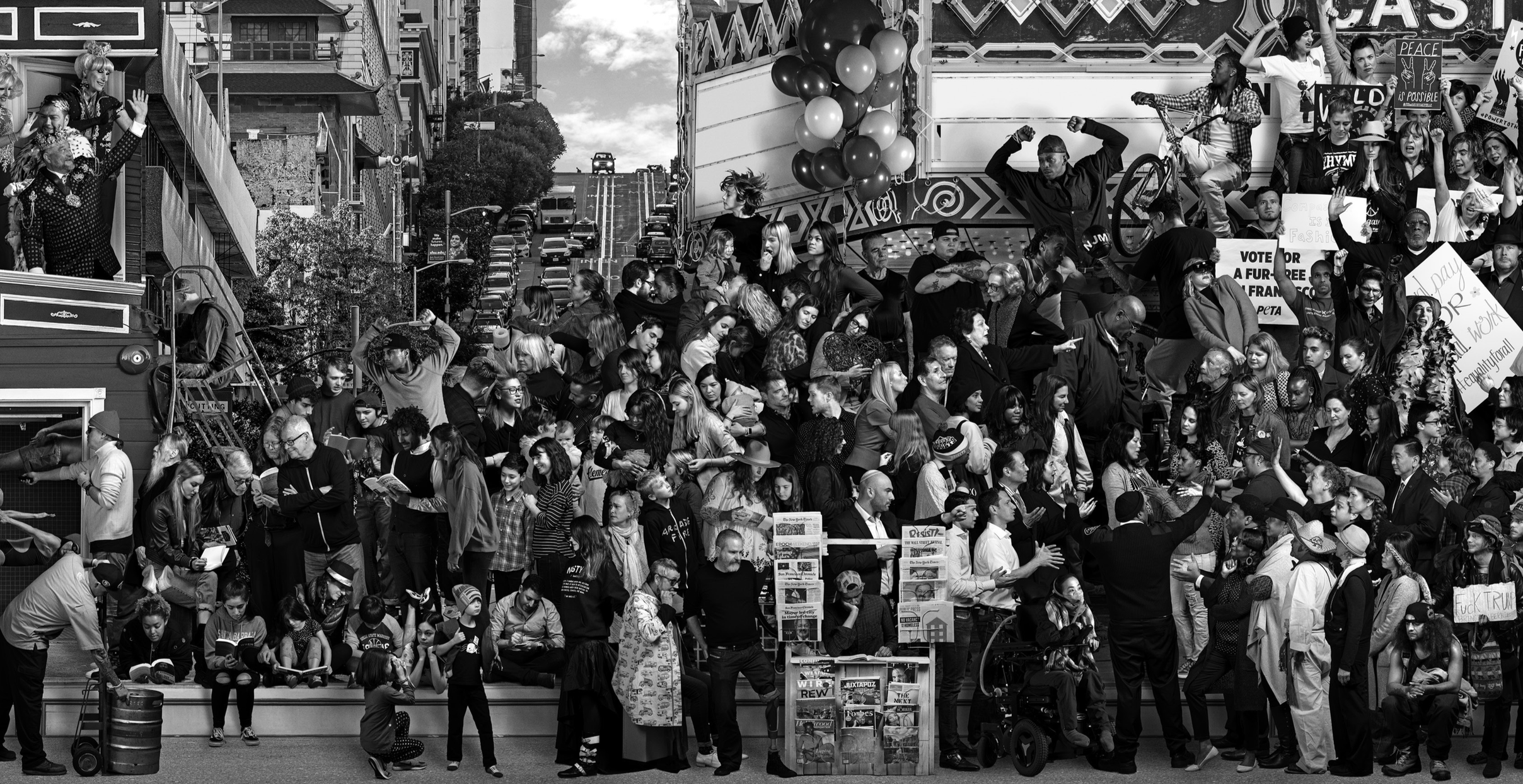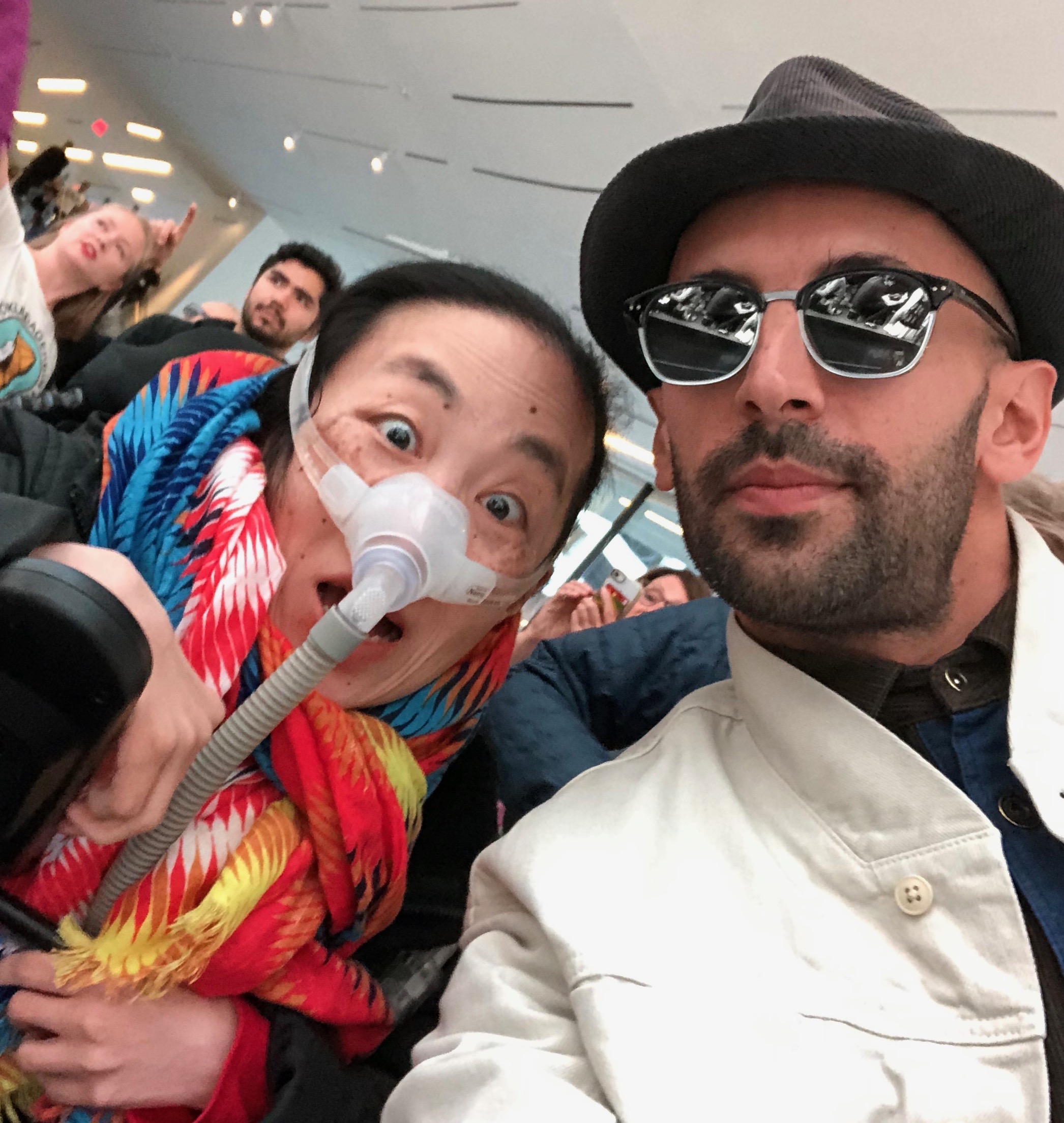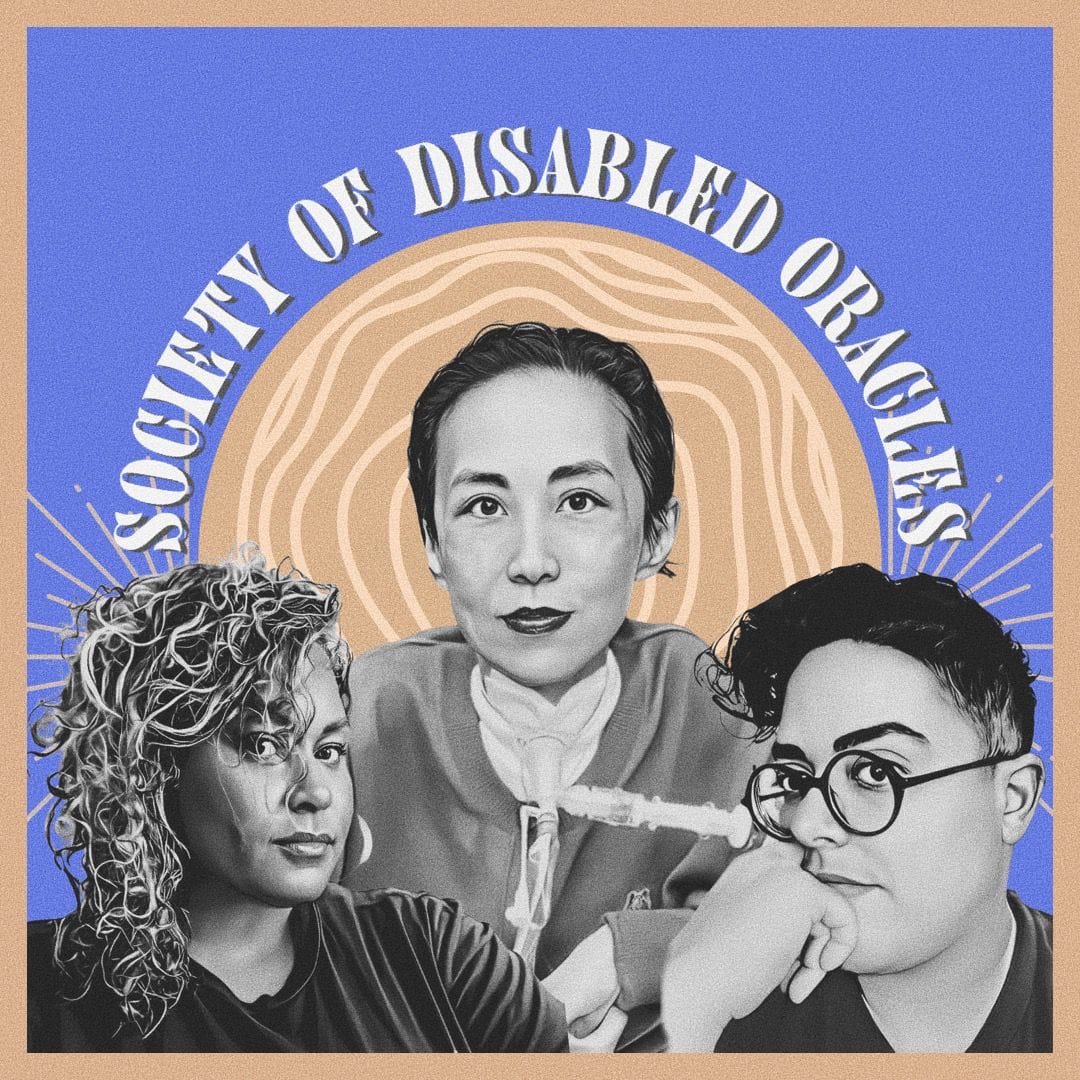For this season of Raw Material, SFMOMA is collaborating with activist, writer, mischief- and media-maker, and self-described “cyborg oracle” Alice Wong to share five episodes from her Disability Visibility podcast that bring listeners to the intersection of art and disability.

Digital portrait of an east asian woman who has black hair pulled back. She is wearing red lipstick, a tiger themed gray sweatshirt, and orange pants as she has a trach in her neck that is attached to a device that she is holding gently in her hands. She is sitting in her power wheelchair. The background is art nouveau inspired and tiger stripe themed with magnolias and tiger lilies and the color theme is mostly orange and black and white.
Image caption: Michaela Oteri, Alice Wong, from the Disabled Beauty Series, 2023; © Michaela Oteri; ogrefairy.com
Through tell-it-like-it-is stories and interviews, the podcast shares the art-making processes and experiences of disabled artists, visitors, and advocates — from creative choices and adaptations borne of physical necessity; to the liberation, release, and connection that making and experiencing art provide; to issues of access and inclusion in museum and performance settings. Each episode is paired with a work in SFMOMA’s art collection that touches on disability, accessibility, or inclusion. Written transcripts will accompany the five episodes.
The partnership and artwork pairings reflect SFMOMA’s organizational focus on the work of disabled artists and how the Raw Material platform can help visitors better understand SFMOMA’s collection. Acquiring and exhibiting works by disabled artists is a priority of SFMOMA, as is improving access and inclusion of disabled visitors to the museum’s galleries, programs, and events.
We recently interviewed Wong about this partnership, the Disability Visibility Project, and how the arts community can support and amplify the call for disability justice. Her best-selling memoir, Year of the Tiger: An Activist’s Life, was published last fall.
Alice Wong Interview
1. What does this partnership between the Disability Visibility Project and SFMOMA offer to art lovers?
I hope art lovers think of disability as a vibrant culture. These podcast episodes highlight the brilliance, creativity, innovation, and wisdom of disabled artists who have historically been pigeonholed or not taken seriously by the art world.
I invite art lovers to question their presumptions of what “good” art is and how ableist our conceptions of art can be. For example, why is art so heavily centered on the visual? I’d like people to consider the following questions: What does a world look like through a disabled lens? Why do exhibitions continue to be at a distance rather than allowing people to touch, feel, and understand art using all the senses? Why aren’t there more benches in museums allowing people to rest? Why aren’t disabled curators, like Amanda Cachia [featured in episode 5 of this season], creating exhibitions of disabled artists at major museums? Why does art history often erase or hide the stories of disabled artists whether they identify or not? If museums and other cultural institutions claim to care about diversity, equity, and inclusion, why don’t they hire disabled people and have staff positions in charge of accessibility and community engagement?
2. What led you to start the Disability Visibility podcast?
As the title of my podcast suggests, I wanted to create something for disabled people by disabled people. When I first thought of making a podcast I was quite intimidated and took my time learning skills in preparation for it. I enjoy a creative challenge even if it’s scary and risky. I wanted to learn how to tell stories in this medium which is different from text. I learned a new set of skills and discovered that being an editor and writer served me well when producing episodes. It didn’t matter if it became successful or not because the creative process was joyful and its own reward. It feels good knowing these stories will be out there forever.
3. What interested you about taking part in this project with SFMOMA and Raw Material?
When Myisa Plancq-Graham [a producer of Raw Material] reached out last fall about this project, I was delighted and surprised because I’m still stunned that people have heard of my podcast. The timing was fortuitous because it was only months after I was hospitalized for four weeks in the ICU. I got a tracheostomy and lost my ability to speak. My voice is now an artificial one from a text-to-speech app and I didn’t know if I would ever be on radio or a podcast again. It’s been a pleasure and a real gift to partner with SFMOMA. I got to push myself creatively again and take a risk on how people would perceive my new voice.
I haven’t been to a museum in over three years and miss it terribly. It’s still not safe for me as a high-risk person to be in an indoor public space and it is disheartening to see able-bodied people gleefully return to “normalcy” while people like me are left behind. Museums pivoted during the pandemic offering online exhibitions and programming and it’s sad to see many of these accessible options disappear now.
4. Disability Visibility includes 100 podcast episodes. Why did you choose to feature these five podcasts in this season of SFMOMA’s Raw Material?
These five episodes are just a small sample of the vast diversity of disabled artists. The interviews feature artists, dancers, and curators discussing accessibility, technology, decolonization, disability justice, and more. Conversations by and for disabled people are still a rarity in the podcast world and I welcome people to soak up the richness. I would love to do a limited series podcast or have a radio show centered on disabled creatives.
5. What can museums do to improve accessibility for visitors with a disability?
First, a quick story. I was dying to see Yayoi Kusama’s Infinity Mirror exhibition when it toured the U.S. I entertained the idea of going to see it in Los Angeles since it wasn’t coming to the Bay Area. I heard from other wheelchair users that the exhibition wasn’t accessible and I emailed the museum asking for specifics. I learned that Infinity Mirror has very narrow pathways visitors must navigate when exploring Kusama’s artwork. My wheelchair would not fit in the pathway nor would I have space to turn. I was extremely disappointed. I wish that in the conceptualization and design of an exhibition, space and accessibility would be prioritized as much as the aesthetic or sensory experience an artist or curator might envision.
I’d love for all programming to have a hybrid component so that people around the world can participate virtually. Since we are entering the fourth year of the pandemic, museums and other arts institutions should require masks for all visitors as policy. Wearing masks is an act of care for one another. Since most arts institutions are in enclosed spaces with ventilation that may vary, requiring masks will protect staff and allow people like me to safely engage with the amazing art on display. During the pandemic there were many exhibitions I wanted to see but couldn’t, such as Diego Rivera’s America at SFMOMA. I’d also like to go back to SFMOMA’s cafe for a latte one day! I can’t wait for this damn plague to be over.
6. What is one of your favorite or most memorable museum experiences?
The first artwork that left me awestruck was Claude Monet’s Peaches (1883). I was in an impressionist phase when I was a teenager living in Indianapolis and I convinced my parents to take my friends and me to The Art Institute in Chicago. Seeing this huge oil painting in front of me was completely different from a poster or image in a book. While the exhibition was packed with people flowing from room to room, I stayed put in front of it as long as I could.
Recently, I loved JR’s digital mural The Chronicles of San Francisco (2018). I participated in this project and it was so much fun. When it opened at SFMOMA in 2019, it was such a joyous occasion. I was mesmerized seeing how all these images of everyday San Franciscans came together.

JR, The Chronicles of San Francisco, 2018 (detail); collection the artist; photo: courtesy JR-art.net

Alice Wong with JR at the opening of The Chronicles of San Francisco at SFMOMA, 2019; photo: courtesy Alice Wong
7. Is there a specific work or art practice you find yourself returning to again and again? Why?
For me, being an artist means being in community with others. The practice I hold close to me is building relationships and collaborations. Ideas can evolve into amazing projects when you work with your peers. Several years ago, I helped fund the creation of Alt Text as Poetry, a project by disabled artists Finnegan Shannon and Bojana Coklyat. One of my recent collaborations is The Society of Disabled Oracles with Aimi Hamraie and artist Jen White-Johnson who designed the beautiful graphics for this season of Raw Material. I am such a fan of Aimi and Jen’s work, and creating something together was generative.

Jen White-Johnson, Society of Disabled Oracles; © Jen White-Johnson
8. I’d like to ask a variation of a question you asked in your podcast “Disabled Artists” [episode 2 of this season]: “What did art do for you in terms of helping you explore your life as a disabled person?”
Art opened up the world and made me feel free. That is the power of art and I truly believe art is for everyone whether they consider themselves an artist or not. You don’t need a degree in art history or to go to fancy museums to appreciate art. Street art, gardens, memes, found objects — art exists everywhere and knowing that I had access to it and could create it was significant for me as a disabled person who was made to feel powerless for much of my life.
9. What’s your take on why or how museums matter today? What role would you like to see museums take on in society?
Museums, like libraries, play an important role in our culture. Museums must change with the times and address the systemic problems that exclude many marginalized communities. Museums must acknowledge that they historically and currently uphold white supremacy, colonialism, ableism, and heteropatriarchy. All one needs to do is look at the demographics of people who work in the world of museums, galleries, and other arts institutions and the kinds of artists and exhibitions that are promoted. The reliance of donors and philanthropy to fund museums widens the divide between the rich and the poor. Everything we love is problematic but museums, whether private or public, belong to the people and the people need to have a larger role in driving decisions behind museums. This is the future I’d like to see.